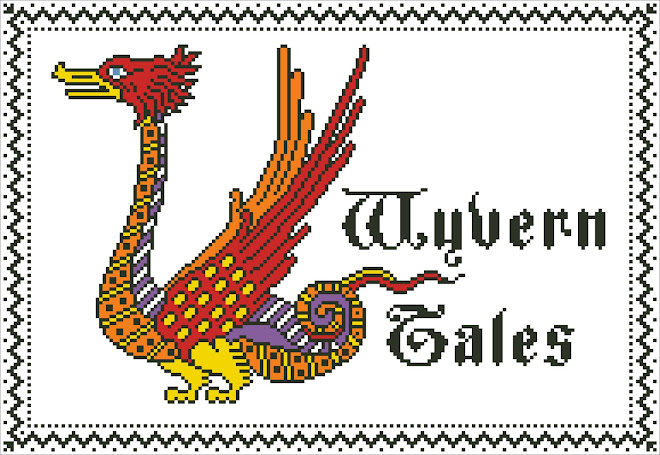 Droll adj. amusingly odd or whimsically comical. That certainly sums up those strange little creatures that inhabit the margins of medieval illuminated manuscripts. Sometimes called grotesques or hybrids, drolleries were mixed-up characters, such as an animal and a human, an animal and a plant, or two different animals. This little fellow to the left is from the 13th/14th century Ormesby Psalter done in England.
Droll adj. amusingly odd or whimsically comical. That certainly sums up those strange little creatures that inhabit the margins of medieval illuminated manuscripts. Sometimes called grotesques or hybrids, drolleries were mixed-up characters, such as an animal and a human, an animal and a plant, or two different animals. This little fellow to the left is from the 13th/14th century Ormesby Psalter done in England. The Romance of Alexander, a 14th-century manuscript from Flanders, offers these delightful dancing drolleries. (The "line dancing" idea just seemed appropriate!)
The Romance of Alexander, a 14th-century manuscript from Flanders, offers these delightful dancing drolleries. (The "line dancing" idea just seemed appropriate!) Margot Nishimura, in her book, Images in the Margins, talks about "marginalia", those images or words placed in the margins of manuscripts that were designed by the medieval artist to fill out a page of text with pertinent or simply whimsical illustrations.
 She says, "Unpredictable, topical, and often irreverent, like the New Yorker cartoons of today, marginalia must have been a great delight for medieval readers." Popular especially in French, English, and Italian manuscripts of the Gothic era (13th to 15th centuries), what is particularly surprising is that these droll marginalia appeared most often and in the greatest number in books of Christian worship. As Nishimura goes on to state, "the images in the margins betray a culture surprisingly at ease with the mingling of the sacred and the profane." But even stranger is the fact that "no one explanation satisfies our desire to find meaning in these out-of-the-way and sometimes ribald images."
She says, "Unpredictable, topical, and often irreverent, like the New Yorker cartoons of today, marginalia must have been a great delight for medieval readers." Popular especially in French, English, and Italian manuscripts of the Gothic era (13th to 15th centuries), what is particularly surprising is that these droll marginalia appeared most often and in the greatest number in books of Christian worship. As Nishimura goes on to state, "the images in the margins betray a culture surprisingly at ease with the mingling of the sacred and the profane." But even stranger is the fact that "no one explanation satisfies our desire to find meaning in these out-of-the-way and sometimes ribald images." This odd elephant-bird comes from a 14th-century French manuscript, the Smithfield Decretals, that was illustrated in England.
 M.M. Bakhtin, in his book, Rabelais and His World, says "The men of the Middle Ages participated in two lives: the official and the carnival life. Two aspects of the world, the serious and the laughing aspect, co-existed in their consciousness. This co-existence was strikingly reflected in ... illuminated manuscripts ... Here we find on the same page strictly pious illustrations ... as well as free designs not connected with the story. The free designs represent chimeras (fantastic forms combinging human, animal, and vegetable elements), comic devils, jugglers performing acrobatic tricks, masquerade figures, and parodical scenes -- that is, purely grotesque carnivalesque themes ..." This particular drollery comes from a 14th century French manuscript, Decretum by Gratian.
M.M. Bakhtin, in his book, Rabelais and His World, says "The men of the Middle Ages participated in two lives: the official and the carnival life. Two aspects of the world, the serious and the laughing aspect, co-existed in their consciousness. This co-existence was strikingly reflected in ... illuminated manuscripts ... Here we find on the same page strictly pious illustrations ... as well as free designs not connected with the story. The free designs represent chimeras (fantastic forms combinging human, animal, and vegetable elements), comic devils, jugglers performing acrobatic tricks, masquerade figures, and parodical scenes -- that is, purely grotesque carnivalesque themes ..." This particular drollery comes from a 14th century French manuscript, Decretum by Gratian.  We are already familiar with many drolleries: the dragon, the griffin, the harpy, the sphynx, the wyvern, the winged horse. These are creatures known to us from childhood stories of castles and fair maidens and heroic knights and exotic lands. But then there are the ones, such as this 5th-century Roman creature, that are just a bit more extraordinary, a bit stranger with its combination of horse, fish, and bird.
We are already familiar with many drolleries: the dragon, the griffin, the harpy, the sphynx, the wyvern, the winged horse. These are creatures known to us from childhood stories of castles and fair maidens and heroic knights and exotic lands. But then there are the ones, such as this 5th-century Roman creature, that are just a bit more extraordinary, a bit stranger with its combination of horse, fish, and bird.For further reading about drolleries and marginalia in medieval manuscripts, I recommend the following books.
Bovey, Alixe. Monsters and Grotesques in Medieval Manuscripts. University of Toronto Press, 2002.
Camille, Michael. Image on the Edge: The Margins of Medieval Art. Harvard University Press, 1992.
Jones, Malcolm. The Secret Middle Ages. Sutton Publishing, 2002.
Morrison, Elizabeth. Beasts Factual & Fantastic. The J. Paul Getty Museum and The British Library, 2007.
Nishimura, Margot. Images in the Margins. The J. Paul Getty Museum and The British Library, 2009.


No comments:
Post a Comment